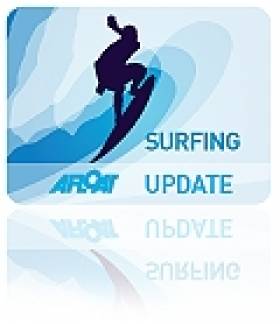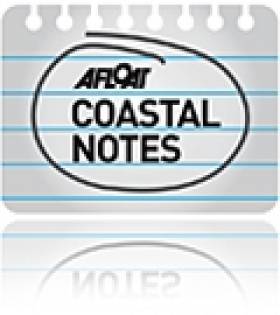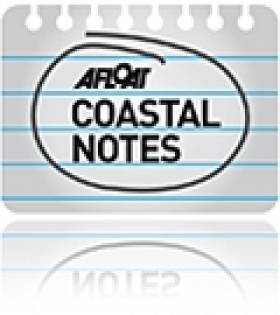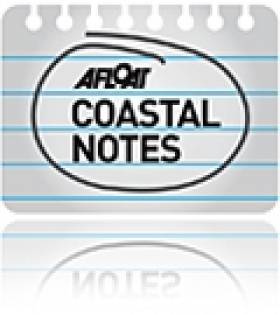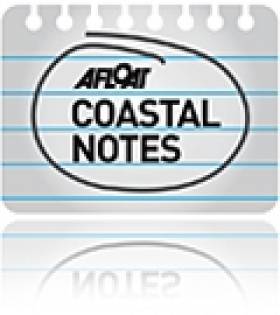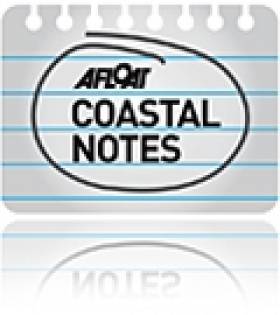Displaying items by tag: Coastal Notes
Ireland's Top Surfing Spots - In Infographic Form
#Surfing - Do you know the best places to surf in Ireland?
Perhaps you've read our many stories on the brave and bold waveriders at Mullaghmore Head. Or the dangerous surf at Lahinch in Co Clare that caused significant damage in January's storms.
But did you know Portrush in Co Antrim is great for kids just getting started on the waves? Or that some of the best surf for beginners can be found on in West Cork?
That and more can be learned from this fascinating infographic courtesy of the Ocean Sands Hotel in Enniscrone, Co Sligo, which provides hospitality at the heart of the northwest's big wave surfing axis.
Maybe it will teach you something new about Ireland's surfing legacy - and encourage you to take to the waves this summer!

€550k Facilities Upgrade Plan For Cliffs Of Moher
#CliffsOfMoher - The visitor centre at the Cliffs of Moher, one of the most high profile and best known discovery points along the newly launched Wild Atlantic Way, is to benefit from significant upgrade works during the coming weeks.
Management at the Cliffs of Moher Visitor Experience in Co Clare have announced a €550,000 plan to upgrade the existing public car park, provide additional coach parking, and upgrade the centre's exhibition.
Contracts have already been awarded for the coach parking and exhibition upgrades, with works due to commence shortly, while a planning application has been submitted in respect of the proposed car park improvements.
Mayor of Clare Cllr Joe Arkins welcomed the announcement, saucing: "The Wild Atlantic Way presents significant opportunities for tourism development right along the western seaboard of Ireland with Clare prominently featured as part of the new touring route that stretches from Donegal to West Cork.
"The proposed upgrade works at the Cliffs of Moher will complement what is already a high quality visitor attraction and will enable management at the cliffs to build on the impressive visitor number increases experienced during the past three years."
Visitor numbers at the Cliffs of Moher Visitor Experience were up 10% during 2013. Some 960,134 people visited the world famous tourist attraction last year compared to 873,988 during the previous year.
It is the third successive increase in visitor numbers to the Cliffs of Moher with year-on-year increases of 12% and 8% being achieved during 2011 and 2012 respectively.
Commenting on the proposed works, cliffs director Katherine Webster said: "The upgrades to the coach park and car park will provide an improved experience for our group and car based customers with increased capacity and a better layout including e-car charging points, additional disabled parking and improved pedestrian flow.
"The new exhibition content will bring fresh exciting new experiences and greater visitor interactivity to the Cliffs Exhibition. The upgrade is being provided by Dublin-based Rockbrook Engineering, and we’re delighted with how their proposals will bring some of the outdoor experience of the cliffs inside into the dome area."
The Cliffs of Moher Visitor Experience is one of three Signature Discovery Points in Co Clare along the route of the Wild Atlantic Way, the others being the Bridges of Ross and Loop Head Lighthouse.
Children’s Art Competition Prize Winners Join National Maritime Museum Art Exhibition
#ChildrensArt – As previously reported on Afloat.ie, the Children's Art Competition organised by the National Maritime Museum of Ireland, Dun Laoghaire has been a great success.
The museum thanks all those who participated! It was a hard job for the jury to select the winners from three age categories from which there were more than 600 entries. The museum really wished to have put all the pictures up in the museum, but then there would have been no room for any other exhibits.
To discover who the overall winner is?... take a visit to the museum's website and why not also visit the venue itself!... which is open daily 11am-5pm, for further details also scroll down the same web-page.
All winning pictures are on view in the upstairs gallery. Also previously reported are paintings from the large marine art collection of the Maritime Institute of Ireland where an exhibition is on display until the end of May.
#OilReview - Lorna Siggins of the Irish Times reports that the Shell to Sea campaign group claim that UK consultants Wood Mackenzie has 'close connections' to oil and gas industry.
Shell to Sea have criticised a decision by Minister for Energy Pat Rabbitte to commission a review of Irish oil and gas fiscal terms from the British consultancy which has supplied information to oil and gas interests holding Irish licences.
Consultancy firm Wood Mackenzie, which is described as a "global leader in commercial intelligence for the energy, metals and mining industries", was appointed by Mr Rabbitte to undertake the review, following a public procurement process. To read more, click HERE.
#CoastalNotes - Seven large urban coastal areas are among more than 40 towns nationwide still seeing untreated sewage released into the water supply, the Environmental Protection Agency (EPA) warns.
According to RTÉ News, the EPA says the current situation is in breach of an EU directive issued more than two decades ago.
Yet three large towns – Killybegs in Co Donegal, Ringaskiddy on Cork Harbour and Arklow in Co Wicklow - have been waiting some 13 years for secondary wastewater treatment facilities.
Moreover, it's been found that nearly a third of established secondary treatment plants nationwide do not meet the EU's main effluent standards, prompting serious pollution concerns.
Clifden in Co Galway and the Co Cork towns of Youghal, Cobh and Passage West have also been identified among the bigger urban areas still discharging untreated wastewater into coastal waters.
The news comes just weeks after it was discovered that effluent from an entire town in Co Galway is being piped into a Special Area of Conservation.
RTÉ News has more on the story HERE.
Storms Uncover Ancient 'Drowned' Forest On Galway Coast
#CoastalHeritage - First the recent storms exposed the wreck of a century-old schooner in Co Kerry and the remnants of neolithic graves in Connemara.
But now the severe weather has revealed the existence of ancient forests dating back an incredible 7,500 years.
The Irish Times reports on the incredible discovery on the Galway coast west of Spiddal, where the remains of a 'drowned' forest have been uncovered.
What's most remarkable about the find is that the trees' root systems are still intact, untouched since the Holocene times when wolves and bears where in abundance in Ireland's wild.
The Irish Times has much more on the story HERE.
'Millions' Not Needed To Combat Erosion Threat To Ireland's Coastline Says Academic
#CoastalNotes - Solutions to deal with the erosion of Ireland's coastline to not have to cost "millions", a geography lecturer tells The Irish Times.
The comments by University College Cork's Dr Max Kozachenko follow a less heartening scenario described by fellow UCC academic Prof Robert Devoy, who said last month that erosion rates - exacerbated by increasingly extreme weather - will soon force Ireland's coastal counties to look "very clinically" at what parts are most worth saving via expensive engineering works.
However, Dr Kozachenko says that such a take-it-or-leave-it solution is "simplistic" when a co-ordinated approach involving coastal monitoring and new approaches to managing the effects of wind and wave action could stem the damage to Ireland's coastline for little expense.
He cites the placing of rock fragments in front of protective rock armouring or concrete walls to scatter waves and dissipate their energy as a cheap but effective option, and also notes the success of offshore artificial reefs in Japan that have had the added benefit of assisting in biodiversity.
The Irish Times has much more on the story HERE.
Argentine Delegation to Visit Foxford for Admiral Brown Commemoration
#AdmiralBrown – The Argentine connection with Foxford, Co. Mayo will once again be celebrated when it commemorates the 157th anniversary of the death of its most famous son, Admiral William Brown.
Admiral's Day on March 3 will be celebrated in the village with a piper led procession, which will include the Argentine Ambassador to Ireland, HE Silvia Maria Merega, the Second Secretary Rafael Galetto, from the Embassy of Argentina, Dublin, and representatives of the Irish Naval Service.
This will be followed by Mass at 12 noon and a laying of wreaths as the last post is sounded at the Brown Monument. For more about this year's events which mark the bicentenary of two major naval victories by Brown, the Mayo Advertiser reports.
Children’s Art Competition: Ships, Boats and things that Float!
#ChildrensArt - The National Maritime Museum of Ireland, Dun Laoghaire, is inviting all 5 to 12 year olds to take part in an art competition.
So get involved by gathering an A3 size piece of paper, watercolours, crayons, pencils or magazine cutouts, whatever makes you feel creative, and let your imagination flow!
Entries can be sent to the museum situated in the former Mariners Church on Haigh Terrace or dropped in the front desk. Please make sure you put your name, age and a contact number of email address clearly legible on the back of the painting.
If you are sending your contribution from a school, add the name of the school and your teachers' name and contact details as well.
Winners will be selected at the end of February. Easons Dun Laoghaire has kindly sponsored prizes. The winning pictures will be exhibited alongside their historic predecessors in the museum's upcoming exhibition of maritime paintings and prints from the Maritime Institute of Ireland's own collection.
Storms Expose Neolithic Graves Among Connemara Archaeological Finds
#CoastalHeritage - The recent storms have proven an unexpected boon for archaeologists as the high winds and wave action on Connemara's coast have exposed remains dating back 6,000 years.
According to The Irish Times, parts of a Neolithic bog, along with two medieval burial grounds and traces of dwellings dating back to the 1700s, were among the sites revealed in sand cliffs on the island of Omey off Claddaghduff by the impact of the storms - the same storms that exposed the remains of the shipwreck Sunbeam in Kerry last week.
It's not all good news, however, as archaeologists fear many more priceless treasures were lost by the destruction wrought by the storms - including kitchen middens, preserved waste piles that teach us much about our ancestors' lifestyles.
Meanwhile, as heritage experts look to Ireland's past, residents in the Aran Islands have expressed their concerns about the future - specifically what impact such extreme weather might have on the proposed - and currently postponed - Galway Bay organic fish farm. The Irish Times has more on this story HERE.


























